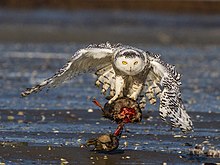
Back بوم ثلجي Arabic بوم ثلجى ARZ Bubo scandiacus AST Wapahowisiw ATJ Noldafa bugimoda AVK Qarlı bayquş Azerbaijani Ҡуян ябалағы Bashkir Сава белая Byelorussian Полярна сова Bulgarian তুষার পেঁচা Bengali/Bangla
| Snowy owl Temporal range: [1]
| |
|---|---|

| |
| A young Snowy owl carries its kill, an American black duck, Biddeford Pool, Maine. | |
| Scientific classification | |
| Domain: | Eukaryota |
| Kingdom: | Animalia |
| Phylum: | Chordata |
| Class: | Aves |
| Order: | Strigiformes |
| Family: | Strigidae |
| Genus: | Bubo |
| Species: | B. scandiacus
|
| Binomial name | |
| Bubo scandiacus | |

| |
Breeding Non Breeding | |
| Synonyms | |
| |
The snowy owl (Bubo scandiacus),[4] also known as the polar owl, the white owl and the Arctic owl,[5] is a large, white owl of the true owl family.[6] Snowy owls are native to the Arctic regions of both North America and the Palearctic, breeding mostly on the tundra.[2] It has a number of unique adaptations to its habitat and lifestyle, which are quite distinct from other extant owls.[7] One of the largest species of owl, it is the only owl with mainly white plumage.[6] Males tend to be a purer white overall while females tend to have more extensive flecks of dark brown.[8] Juvenile male snowy owls have dark markings that may appear similar to females until maturity, at which point they typically turn whiter. The composition of brown markings about the wing, although not foolproof, is the most reliable technique to age and sex individual snowy owls.[9]: 48
Most owls sleep during the day and hunt at night, but the snowy owl is often active during the day, especially in the summertime.[7] The snowy owl is both a specialized and generalist hunter. Its breeding efforts and global population are closely tied to the availability of tundra-dwelling lemmings, but in the non-breeding season, and occasionally during breeding, the snowy owl can adapt to almost any available prey – most often other small mammals and northerly water birds, as well as, opportunistically, carrion.[5][8] Snowy owls typically nest on a small rise on the ground of the tundra.[10] The snowy owl lays a very large clutch of eggs, often from about 5 to 11, with the laying and hatching of eggs considerably staggered.[8] Despite the short Arctic summer, the development of the young takes a relatively long time and independence is sought in autumn.[7]
The snowy owl is a nomadic bird, rarely breeding at the same locations or with the same mates on an annual basis and often not breeding at all if prey is unavailable.[8] A largely migratory bird, snowy owls can wander almost anywhere close to the Arctic, sometimes unpredictably irrupting to the south in large numbers.[8][11] Given the difficulty of surveying such an unpredictable bird, there was little in-depth knowledge historically about the snowy owl's status. However, recent data suggests the species is declining precipitously.[2][12] Whereas the global population was once estimated at over 200,000 individuals, recent data suggests that there are probably fewer than 100,000 individuals globally and that the number of successful breeding pairs is 28,000 or even considerably less.[2][13] While the causes are not well understood, numerous, complex environmental factors often correlated with global warming are probably at the forefront of the fragility of the snowy owl's existence.[2][8]
- ^ "Bubo scandiacus Linnaeus 1758 (snowy owl)". PBDB.
- ^ a b c d e BirdLife International. (2021). "Bubo scandiacus". IUCN Red List of Threatened Species. 2021: e.T22689055A205475036. doi:10.2305/IUCN.UK.2021-3.RLTS.T22689055A205475036.en. Retrieved 3 July 2024.
- ^ "Appendice". CITES. Retrieved 14 January 2022.
- ^ Lewis, Deane (4 July 2022). "Snowy Owl ~ Bubo scandiacus (Nyctea scandiaca)". The Owl Pages. Retrieved 30 December 2022.
- ^ a b Potapov, Eugene & Sale, Richard (2013). The Snowy Owl. T&APoyser. ISBN 978-0713688177.
- ^ a b König, Claus; Weick, Friedhelm (2008). Owls of the World (2nd ed.). London, UK: Christopher Helm. ISBN 9781408108840.
- ^ a b c Voous, Karel H.; Cameron, Ad (illustrator) (1988). Owls of the Northern Hemisphere. London, Collins. pp. 209–219. ISBN 978-0-00-219493-8.
- ^ a b c d e f Holt, D. W.; Larson, M. D.; Smith, N.; Evans, D. L.; Parmelee, D. F. (4 March 2020). Billerman, S. M. (ed.). "Snowy Owl (Bubo scandiacus)". Birds of the World. Cornell Lab of Ornithology, Ithaca, NY, USA. doi:10.2173/bow.snoowl1.01.
- ^ Solheim, R. (2012). "Wing feather moult and age determination of Snowy Owls Bubo scandiacus". Ornis Norvegica. 35: 48–67. doi:10.15845/on.v35i0.289. hdl:11250/2454504.
- ^ Hume, R. (1991). Owls of the world. Running Press, Philadelphia.
- ^ Sindelar Jr., C. (1966). "A comparison of five consecutive Snowy Owl invasions in Wisconsin". Passenger Pigeon. 28 (10): 108.
- ^ Bent, A. C. (1938). Life Histories of North American Birds of Prey (part 2), Orders Falconiformes and Stringiformes (Vol. 170). US Government Printing Office.
- ^ Marthinsen, Gunnhild; Wennerberg, Liv; Solheim, Roar; Lifjeld, Jan T. (2009). "No phylogeographic structure in the circumpolar snowy owl (Bubo scandiacus)". Conservation Genetics. 10 (4): 923–933. Bibcode:2009ConG...10..923M. doi:10.1007/s10592-008-9581-6. S2CID 6706626.
